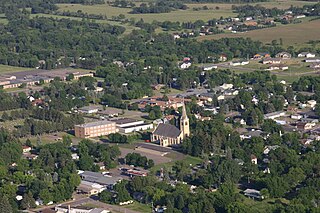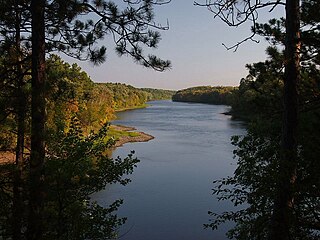Related Research Articles

Morrison County is a county in the U.S. state of Minnesota. As of the 2020 census, the population was 34,010. Its county seat is Little Falls. Camp Ripley Military Reservation occupies a significant area in north-central Morrison County.

Pierz is a city in Morrison County, Minnesota, United States. The population was 1,418 at the 2020 census.

St. Joseph or Saint Joseph is a city in Stearns County, Minnesota, United States. The population was 7,029 at the 2020 census. It is home to the College of Saint Benedict.

Cold Spring is a city in Stearns County, Minnesota, United States, at the gateway of the Sauk River Chain of Lakes, an interconnected system of 14 bay-like lakes fed and connected by the Sauk River. Cold Spring is part of the St. Cloud Metropolitan Statistical Area. Its population was 4,025 at the 2010 census.

The Red Lake Indian Reservation covers 1,260.3 sq mi in parts of nine counties in Minnesota, United States. It is made up of numerous holdings but the largest section is an area about Red Lake, in north-central Minnesota, the largest lake in the state. This section lies primarily in the counties of Beltrami and Clearwater. Land in seven other counties is also part of the reservation. The reservation population was 5,506 in the 2020 census.

Irenaeus Frederic Baraga was a Slovenian Roman Catholic missionary to the United States and a grammarian by and author of Christian poetry and hymns in Native American languages. He became the first bishop of the Roman Catholic Diocese of Marquette, Michigan, originally sited at Sault Sainte Marie, which he led for 15 years.

The White Earth Indian Reservation is home to the White Earth Band, located in northwestern Minnesota. It is the largest Indian reservation in the state by land area. The reservation includes all of Mahnomen County, plus parts of Becker and Clearwater counties in the northwest part of the state along the Wild Rice and White Earth rivers. The reservation's land area is 1,093 square miles (2,830 km2). The population was 9,726 as of the 2020 census, including off-reservation trust land. The White Earth Indian Reservation is one of six bands that make up the Minnesota Chippewa Tribe, their governing body for major administrative needs. It is about 225 miles (362 km) from Minneapolis–Saint Paul and roughly 65 miles (105 km) from Fargo–Moorhead.

The Watab River, also known as Watab Creek, is a 9.8-mile-long (15.8 km) tributary of the Mississippi River in Stearns County in central Minnesota in the United States. It rises north of St. Joseph at the confluence of its North and South Forks, and flows northeast through Watab Lake, then east into the Mississippi River at Sartell.
Mississippi River Band of Chippewa Indians or simply the Mississippi Chippewa, are a historical Ojibwa Band inhabiting the headwaters of the Mississippi River and its tributaries in present-day Minnesota.

Crow Wing State Park is a state park of Minnesota, United States, at the confluence of the Mississippi and Crow Wing Rivers. The park interprets the site of Old Crow Wing, one of the most populous towns in Minnesota in the 1850s and 1860s. The entire park was added to the National Register of Historic Places in 1970. A section of the Red River Trails that passed through Old Crow Wing is also separately listed on the National Register.

The Diocese of Saint Cloud is a Latin Church diocese of the Catholic Church in central Minnesota in the United States. It is a suffragan diocese of the metropolitan Archdiocese of Saint Paul and Minneapolis.

Francis Xavier Pierz was a Roman Catholic priest and missionary to the Ottawa and Ojibwe Indians in present-day Michigan, Wisconsin, Ontario, and Minnesota. Because his letters convinced numerous Catholic German Americans to settle in Central Minnesota after the Treaty of Traverse des Sioux, Fr. Pierz is referred to as the "Father of the Diocese of Saint Cloud."
The culture of Minnesota is a subculture of the United States with influences from Scandinavian Americans, Finnish Americans, Irish Americans, German Americans, Native Americans, Czechoslovak Americans, among numerous other immigrant groups. They work in the context of the cold agricultural and mining state.

Old Crow Wing is a ghost town in Fort Ripley Township, Crow Wing County, Minnesota, United States, at the confluence of the Mississippi and Crow Wing rivers. Long occupied by the Ojibwe people, for over a century it was also the northernmost European-American settlement on the Mississippi.
Joseph Alexander Gilfillan was an Episcopal missionary to Native Americans of the Ojibwa Tribe on White Earth Reservation in northern Minnesota during 35 years from 1873 until 1908.

Assumption Chapel, also known as the Grasshopper Chapel, is a Roman Catholic pilgrimage church situated upon a hill known locally as, meaning "Mary's Mountain", on the outskirts of Cold Spring, Minnesota, in a region of Minnesota largely settled in the 1850s by German-American Catholics who were attracted to the area by Fr. Francis Xavier Pierz. Although inspired by ancient traditions carried to America by local peasant-pioneers from Southern Germany, the chapel was constructed in 1877, as a desperate petition to the Blessed Virgin for relief from the Rocky Mountain locusts; a now extinct species of giant grasshopper, whose enormous migrating swarms blotted out the sunlight and devastated farming communities throughout North America between 1856 and 1902.

The Church of St. Joseph is a historic Roman Catholic church building in St. Joseph, Minnesota, United States. It is part of the Roman Catholic Diocese of Saint Cloud. It was constructed in a German immigrant community in 1869, though the tower wasn't completed until 1884. A rectory stands east of the church. Both buildings were listed on the National Register of Historic Places in 1982 for their state-level significance in the themes of architecture, exploration/settlement, and religion. The property was nominated for reflecting the settlement of rural Stearns County by Catholic immigrant groups clustered in small, ethnic hamlets dominated by a central church.

Jacobs Prairie is an unincorporated community in Wakefield Township, Stearns County, Minnesota, United States. The community is located along Stearns County Road 2 at Glacier Road near Cold Spring and Rockville.

Hole-in-the-Day (1825–1868) was a prominent chief of the Mississippi band of Ojibwe/Chippewa/Anishinaabe in Minnesota. The native pronunciation has been written with different spellings due different speakers variance in their enunciation, such as Bagone-giizhig, Bagwunagijik, Bug-o-nay-ki-shig, Pugonakeshig or Puk-O-Nay-Keshig. Hole-in-the-Day has also been called Hole-in-the-Sky. The name refers to a dream in which the guardian spirit was seen through an opening in the clouds. It also refers to the Anishinaabek name for the constellation of the same name, also known as the Pleiades.

Margaret Bonga Fahlstrom was a mixed-race woman of African and Ojibwe descent who came from a fur trading family in the Great Lakes region. In 1823, she married Jacob Fahlstrom, the first Swedish settler in Minnesota, and lived with him on a small farm at Coldwater Spring near Fort Snelling. Margaret was one of the few free Black women living in the area around the time that enslaved women such as Harriet Robinson Scott were struggling to find a path to freedom. In 1838, the Fahlstroms became the first converts to the Methodist faith in Minnesota, and moved to a farm in Washington County in 1840. Jacob became well known as the Methodist lay preacher "Father Jacob". His success as a traveling Christian missionary was often attributed to his fluency in the Ojibwe language, as well as his marriage. Margaret and her daughters were also known for their involvement in early church meetings in Minnesota, and their hospitality toward Methodist circuit riders.
References
- ↑ Karni, Michael G. (1967). "Otto Walta: Finnish folk hero of the Iron Range" (PDF). Minnesota History . 40 (8): 391–402. JSTOR 20177932.
- ↑ Swanson, Roy (1948). "A Swedish Immigrant Folk Figure: Ola Värmlänning" (PDF). Minnesota History . 29 (2): 105–113. JSTOR 20175384.
- ↑ McDonald, Grace (1929). "Father Francis Pierz Missionary" (PDF). Minnesota History . 10 (2): 107–125. JSTOR 20160783.
- ↑ Stories of Father Pierz, collected on the White Earth Reservation during the 1920s by Father Benno Watrin, OSB. Taken from the Archives of the College of Saint Benedict, St. Joseph, Minnesota. A photocopy is in Father Francis Pierz file in the Archive Room, Stearns County Historical Society, St. Cloud, Minnesota.